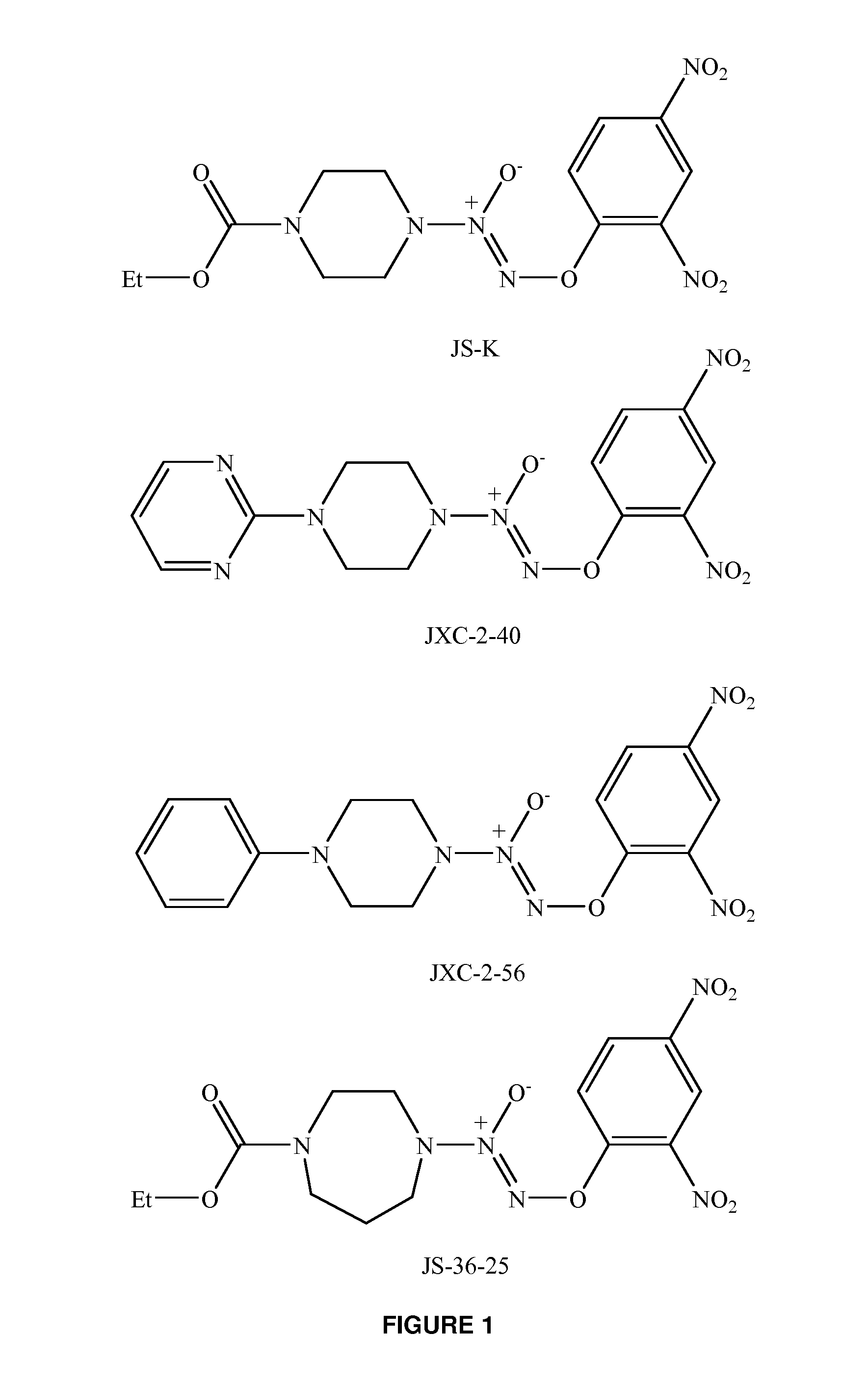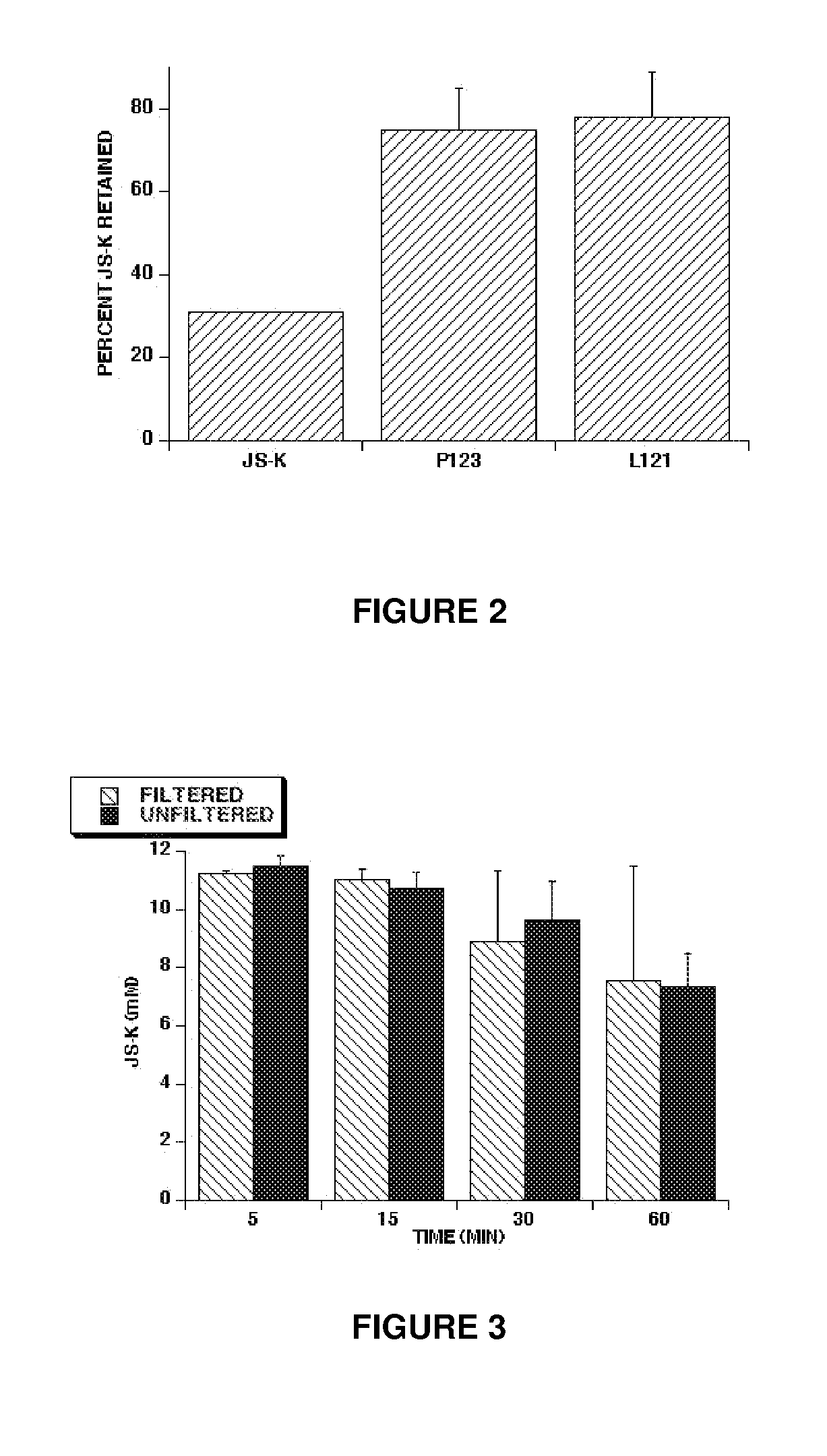Activated nitric oxide donors and methods of making and using thereof
- Summary
- Abstract
- Description
- Claims
- Application Information
AI Technical Summary
Benefits of technology
Problems solved by technology
Method used
Image
Examples
example 1
[0075]This example illustrates the extent of JS-K loading in micelles. JS-K was loaded in Pluronic® P123 and L121 polymers to form micelles. The proportion of JS-K to Pluronic® polymer in solution was 10% by weight. The JS-K micelle preparations were then dialyzed for 2 hours. A parallel experiment following the same procedures with free JS-K was set up as a control. After 2 hours of dialysis, JS-K levels were measured by HPLC to estimate the percent of JS-K retained. Percent retention of free JS-K was only 31% as compared to 75±10% and 78±11% for JS-K in Pluronic® P123 and L121 micelles, respectively, see FIG. 2. The results showed that JS-K in a micellar formulation is retained after dialysis, while free JS-K is mostly lost during dialysis.
example 2
[0076]This example illustrates the effect of filtration on Pluronic® micelles. JS-K was loaded in P123 micelles (the proportion of JS-K to Pluronic® polymer in solution was 1.57% by weight). Aliquots of the JS-K preparation were then filtered through a 0.2 μM membrane filter and kept at room temperature. At regular intervals 20 μL aliquots from the preparations were collected and JS-K levels were measured by HPLC. Parallel measurements were done on similar JS-K formulations in P123 Pluronic® micelles that had not been filtered. Measured JS-K levels went down with time. The results show there were no differences in JS-K concentrations between filtered and unfiltered micelles, suggesting that these micelles can be filtered without degradation, see FIG. 3.
example 3
[0077]This example illustrates that Pluronic® micelles stabilize JS-K in the presence of GSH. In these experiments, free JS-K and JS-K formulated in Pluronic® P-123 micelles were incubated at a concentration of 10 mM with 4.0 mM GSH in PBS at pH 7.4 and room temperature. The proportion of JS-K to Pluronic® polymer in solution was 1.57% by weight. At regular intervals, JS-K levels were measured by HPLC. Under these conditions, free JS-K had a half-life of 6 minutes in the presence of GSH. JS-K in P-123 micelles in the presence of GSH under the same conditions had a half-life of 37 minutes. These results show that Pluronic® micelles substantially prolong the half-life (by 6 fold in the case of P-123) of JS-K under very stringent conditions of nucleophilic attack by free thiols represented by GSH.
PUM
| Property | Measurement | Unit |
|---|---|---|
| Percent by mass | aaaaa | aaaaa |
| Percent by mass | aaaaa | aaaaa |
| Acidity | aaaaa | aaaaa |
Abstract
Description
Claims
Application Information
 Login to View More
Login to View More - R&D
- Intellectual Property
- Life Sciences
- Materials
- Tech Scout
- Unparalleled Data Quality
- Higher Quality Content
- 60% Fewer Hallucinations
Browse by: Latest US Patents, China's latest patents, Technical Efficacy Thesaurus, Application Domain, Technology Topic, Popular Technical Reports.
© 2025 PatSnap. All rights reserved.Legal|Privacy policy|Modern Slavery Act Transparency Statement|Sitemap|About US| Contact US: help@patsnap.com



